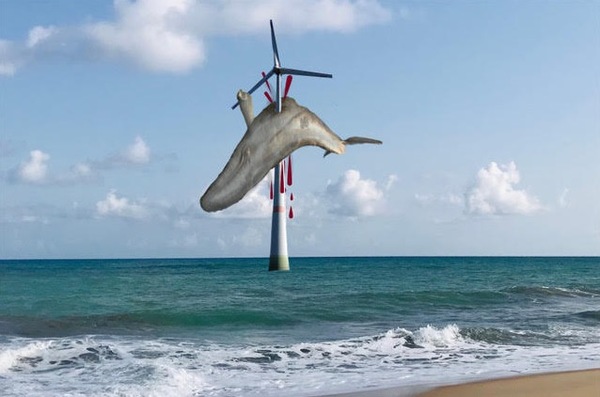
(function(d, s, id) { var js, fjs = d.getElementsByTagName(s)[0]; if (d.getElementById(id)) return; js = d.createElement(s); js.id = id; js.src = “https://connect.facebook.net/en_US/sdk.js#xfbml=1&version=v3.0”; fjs.parentNode.insertBefore(js, fjs); }(document, ‘script’, ‘facebook-jssdk’)); –>
–>
September 15, 2023
There has been an alarming, “mysterious“ rise in whale deaths in the Northeast, coinciding with a massive, subsidized buildout of offshore wind farms. The National Oceanographic and Atmospheric Agency (NOAA,) the federal organization ultimately responsible for reporting on and protecting whales, asserts there is no link between wind farm development and whale deaths.
‘); googletag.cmd.push(function () { googletag.display(‘div-gpt-ad-1609268089992-0’); }); document.write(”); googletag.cmd.push(function() { googletag.pubads().addEventListener(‘slotRenderEnded’, function(event) { if (event.slot.getSlotElementId() == “div-hre-Americanthinker—New-3028”) { googletag.display(“div-hre-Americanthinker—New-3028”); } }); }); }
At the same time, NOAA now issues expedited whale “take,” or harm and kill permits, to wind companies. The likely “link” between deaths and NOAA permits—deafening and disorienting acoustic pulses generated for sub-seafloor seismic surveying and construction—is commonly acknowledged by marine mammal biologists and undersea acousticians, yet it is now publicly ignored or suppressed. The price of these absurdities may include the imminent extinction of the North Atlantic right whale.
Greenpeace co-founder Patrick Moore describes the current Northeast US whale migration pathway as a “death zone.” For example, since 2016, the starting year of the most recent “Unusual Mortality Events” for whales, over 200 Humpbacks have beached or stranded.
The year 2016 also marked the beginning of a frenzied, subsidized buildout of offshore wind in the Northeast US. Today, as pre-construction surveying and build-out of new turbines promised by the Executive branch continues, dolphins and whales are found beached or floating lifeless offshore on an almost daily basis. Many animals are never found, are never reported, or are only documented informally. This cetacean die-off threatens the last of 340 remaining North Atlantic right whales, including as few as 70 reproductive females.

Image by Ken Swope.
‘); googletag.cmd.push(function () { googletag.display(‘div-gpt-ad-1609270365559-0’); }); document.write(”); googletag.cmd.push(function() { googletag.pubads().addEventListener(‘slotRenderEnded’, function(event) { if (event.slot.getSlotElementId() == “div-hre-Americanthinker—New-3035”) { googletag.display(“div-hre-Americanthinker—New-3035”); } }); }); }
While disavowing any connection between wind development and whale harm, NOAA now expedites authorizing “incidental” whale harassment and “take” by wind companies. While killing of whales is illegal, there are exceptions. Under the Marine Mammal Protection Act (MMPA) of 1972, take or harassment and possible killing, is prohibited, but “provided certain findings are made, NOAA Fisheries may issue incidental take authorizations allowing the unintentional “take” of marine mammals incidental to specified activities, including construction projects.
“Take,” under the MMPA, “is defined as the intent to harm, harass, or kill a marine mammal, in its simplest terms,” says NOAA’s Mendy Garron, Acting Communications Director at NOAA’s Greater Atlantic Regional Fisheries Office. NOAA stipulates, “Incidental take is an unintentional, but not unexpected, impact to a marine mammal that can range from a non-minor behavioral response, to an injury, to a mortality.” The deaths are not intended but expected.
NOAA acknowledges the impact of human-generated noise on whales, but officially rejects the effects of wind farm development. Benjamin Laws, deputy chief for permits and construction at NOAA, stated, “we do not have evidence that would support the connection between the [wind] survey work and these recent stranding events or any stranding events in the last several years.”
NOAA attributes deaths to “human interaction,” specifically ship-strike or fishing gear entanglement. These causes are more easily discovered in necropsies than internal organ (hearing) damage. (According to NOAA, many whales are significantly decomposed by the time they are discovered.) NOAA blames fishing and ships, except for offshore wind survey ships.
But powerful sound waves can harm both toothed and baleen whales. Whale strandings have been linked to hearing damage and disorientation from high-intensity, low-frequency sonar pulses like those used in wind farm pre-construction surveys. In 2015, the National Resources Defense Council (NRDC) reported, “we now know that intense sound waves can have direct physiological impacts on whales, including internal hemorrhaging.”
For creatures who navigate using sound, vessel strikes, entanglement, and hearing damage are not mutually exclusive causes of death.
‘); googletag.cmd.push(function () { googletag.display(‘div-gpt-ad-1609268078422-0’); }); document.write(”); googletag.cmd.push(function() { googletag.pubads().addEventListener(‘slotRenderEnded’, function(event) { if (event.slot.getSlotElementId() == “div-hre-Americanthinker—New-3027”) { googletag.display(“div-hre-Americanthinker—New-3027”); } }); }); } if (publir_show_ads) { document.write(“
According to Greenpeace’s senior research specialist Tim Donaghy (in words often attributed to famed biologist Sylvia Earle,) “a deaf whale is a dead whale.” Bonnie Brady of the Long Island Commercial Fishing Association explains “we are often told these are ship-strikes and they have nothing to do with offshore wind. But the wind survey boats are out there harassing whales with low-frequency pulses right where they breathe, feed, and nurse. A whale that can’t hear is far more likely to get hit by a ship.”
The wind companies’ hired survey boats use high-energy acoustic pulses to map the ocean floor and sub-floor for wind turbine placement. These pulses can adversely affect and damage the internal hearing function and organs of whales, all of which use sound to communicate and some to navigate and find prey.
“SONAR has a range of impacts on marine mammals. On one end of the scale, you have outright death. If you’re close enough to a SONAR source with the kind of high-intensity sound that is emitted from those sources, it can lead to internal organ damage,” said Zac Smith, staff attorney at the NRDC. “There are indications of bleeding from the ears and the eyes, so there’s those kinds of impacts at the very closest range, the most horrible ones.”
The connection between powerful sound waves and the whales’ health is not disputed. A U.S. Navy study in 2001 revealed that whales were killed in an accident involving ship-based low-frequency active SONAR. These systems and the seismic survey sonar and airgun/horn systems used by hydrographic survey vessels operate in similar and overlapping frequency and intensity ranges.
One NOAA official has sounded the alarm. In a recently disclosed memo, Dr. Sean Hayes, Chief of Protected Species at NOAA, warned the Bureau of Ocean Energy Management of the risks of offshore wind development to North Atlantic right whales. “The development of offshore wind poses risks to these species, which is magnified in southern New England waters due to species abundance and distribution.”
Even as deaths have increased, NOAA’s “take” permitting has increased. A comparison between past years‘ and current Incidental Take authorizations shows a drastic increase in size and scope. Take Permits are now active or in process for Dominion Energy, US Wind, Community Offshore Wind, Attentive Energy, Atlantic Shores Offshore Wind, SouthCoastWind Energy, Orsted Wind, BluePoint, Vineyard NorthEast, and others.
According to NOAA’s list of all applied and granted Incidental Harassment (IHA) and Take Authorizations since 2016, permits for offshore wind activities in the Atlantic north of Florida numerically overwhelm any others granted for that area. Since 2016, from Virginia to Massachusetts, 56 separate marine mammal IHAs, many overlapping in time and geographic area, received permits.
The Feds have been cautioned. In a 2022 memo, a consortium of 15 environmental groups warned NOAA and the Bureau of Ocean Energy Management “Since June 2017, NOAA Fisheries has permitted or is considering permitting 108 vessels to conduct geophysical survey activities over more than 10,000 survey days, resulting in more than 113,000 instances of harassment (i.e., Level B takes) of marine mammals. Of those takes, 402 represent North Atlantic right whales—a number now greater than the population size of the species.”
Construction of new turbines has now begun in Southern New England, where the North Atlantic right whale feeds. Survey vessels continue to zig-zag off the coast, bombarding the sea with powerful sound waves. Forthcoming pile-driving of turbine towers will increase sound intensities exponentially. As Minke whales, Humpbacks, and dolphins die, the ultimate fate of the critically endangered North Atlantic right whale draws near.
Franklin Raff is a U.S. Coast Guard licensed professional captain and is host and co-producer of the multiple Emmy-Award® winning PBS conservation documentary Great White Shark (The Great White Shift,) now in worldwide distribution.
<!–
–>
<!– if(page_width_onload <= 479) { document.write("
“); googletag.cmd.push(function() { googletag.display(‘div-gpt-ad-1345489840937-4’); }); } –> If you experience technical problems, please write to [email protected]
FOLLOW US ON
<!–
–>
<!– _qoptions={ qacct:”p-9bKF-NgTuSFM6″ }; ![]() –> <!—-> <!– var addthis_share = { email_template: “new_template” } –>
–> <!—-> <!– var addthis_share = { email_template: “new_template” } –>





